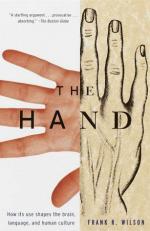|
This section contains 349 words (approx. 1 page at 400 words per page) |

|
The Twenty-Four-Karat Thumb Summary and Analysis
Not until Sir Charles Bell describes a human hand as the "consummation of all perfection as an instrument" do modern studies of its structure and function begin, to be followed a century later by Frederick Wood Jones noting that it is actually the brain in control. Until then it is the thumb that sets the human hand apart from the apes. Napier identifies the grip of the hand that supersedes the thumb. Mary Marzke follows up on Napier's initial work to classify three types of grip that are defined as pad-to-side, three-jawed chuck and five-jawed cradle. She identifies eight features of the human hand that includes a longer thumb, wider fingertip pads, thumb muscle modification and long flexor as well as metacarpal and wrist bone changes. Marzke incorporates expanded use of the palm in her identified grips...
(read more from the The Twenty-Four-Karat Thumb Summary)
|
This section contains 349 words (approx. 1 page at 400 words per page) |

|




